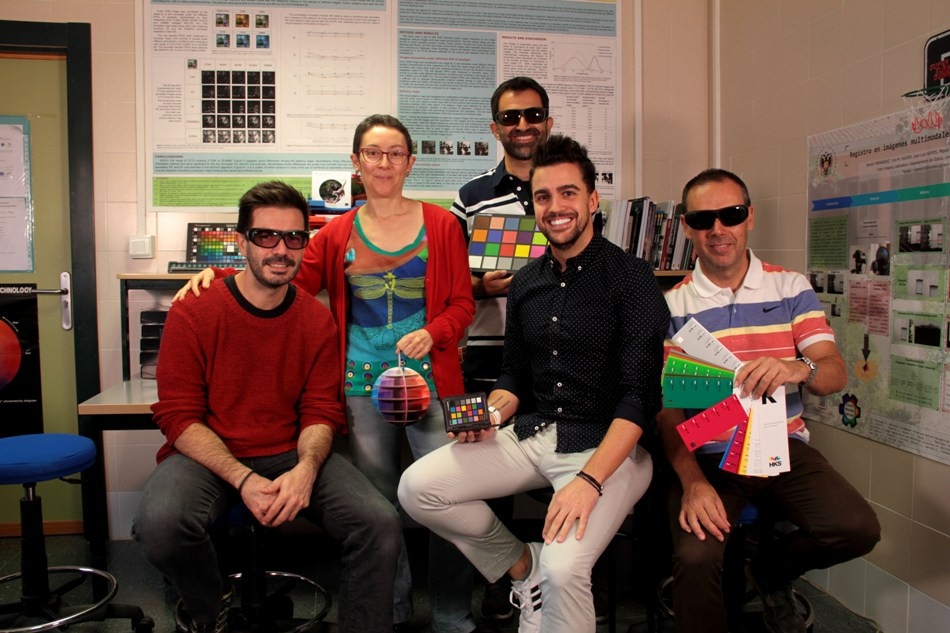Oct 30 2018
Following the recent commercialization of the EnChroma® glasses, a vigorous campaign in the social media and networks has led to increased expectations among the color-blind people. They look forward to viewing new colors or even correcting their color blindness with the help of these glasses.
 The UGR researchers posing with the EnChroma® glasses for color-blind people studied in this research. From left to right: Luis Gómez, Eva Valero, Javier Hernández, Miguel Ángel Martínez, and Rafael Huertas (Image credit: University of Granada)
The UGR researchers posing with the EnChroma® glasses for color-blind people studied in this research. From left to right: Luis Gómez, Eva Valero, Javier Hernández, Miguel Ángel Martínez, and Rafael Huertas (Image credit: University of Granada)
The North American company that manufactures these glasses has advertised an enhancement in color vision for specific types of color blindness, protan and deutan, by widening the range of colors viewed by the subject without any impact on the colors that are already perceived without glasses. Indeed, on its website, EnChroma® states that the glasses “alleviate red‑green color blindness, enhancing colors without the compromise of color accuracy,” but also claims that the glasses “may not work” for severe red‑green deficiency.
On the company’s website, one claim (at least until October 2017) states that the glasses “are designed to improve the everyday experience of color vision”. However, recently, a more subtle sentence has substituted that claim: “the glasses are an optical assistive device for enhancement of color discrimination in persons with color blindness; they are not a cure for color blindness”, indicating that “results vary depending on the type and extent of color vision deficiency per individual.”
In an article published in Optics Express, one of the most relevant journals with a great effect in the area of optics, scientists from the University of Granada (UGR) have shown the effectiveness of these glasses for color vision deficiency (CVD) in true light, proving that the EnChroma® glasses do not transform the vision of color-blind people comparable to that of people without color blindness.
A study with 48 color-blind volunteers
In this UGR study, 48 people with color blindness participated, following a public call to which over 200 volunteers responded. For the first time, the scientists have used two complementary approaches to assess the effectiveness of the glasses. The first approach involved the assessment of the color vision of the participants with and without glasses through tests of various kinds: the Ishihara test (recognition) and the Fansworth‑Munsell test (arrangement). Apart from this, they have added a test based on the X‑Rite Color Chart, which assesses subjective color‑naming.
The second strategy for the assessment of the effectiveness of these glasses involved the use of the spectral transmittance of the lenses to simulate different observers, which enabled the assessment of the variations in color appearance.
Luis Gómez Robledo, professor from the UGR Department of Optics and one of the authors of this study stated that “normal human color vision is trichromatic thanks to a cluster of three types of photoreceptors known as cones, which are present in the retina. These cones are sensitive to short wavelengths (S), medium wavelengths (M) and long wavelengths (L). However in Europe, about 8% of men and 0.5% of women in the Caucasian population suffer from some type of congenital anomaly in the performance of some of the cones, which causes color vision deficiencies. This anomaly is a sex‑linked recessive trait, with the red‑green color vision deficiency being the most frequent in humans.” The mentioned red‑green CVD can, in turn, be categorized into two types: protan and deutan, based on the affected cones. Furthermore, there is one more classification, which is dependent on the severity of the deficiency: protanomalous or deuteranomalous, and protanopic or deuteranopic.
Glasses similar to those used for hunting
This research performed by the UGR demonstrates that a color-blind person who uses the EnChroma® glasses will not see new colors; instead, the person will see the same colors in a different way.
“This makes possible for some individuals using these glasses to distinguish some colors, but to the detriment of others which will be now confused. Even though a color filter as that used by the EnChroma® glasses may change the appearance of colors, it will never make color vision more similar to a normal observer’s vision,” the authors said.
When used, the EnChroma® glasses provide an impact similar to that provided by glasses designed for particular activities, such as hunting, shooting, low eyesight, and so on, where the use of colored glasses offers a better perception of specific stimuli due to an increased contrast with the surroundings.
Apart from this, during the study, the observers were instructed to view their surroundings using the glasses and to subjectively evaluate the possible improvement. The participants could not observe any enhancement in the colors of their surroundings while using the glasses, except for just one female participant with very mild deuteranomaly.
The outcomes indicate that the glasses particularly used in this research have not exhibited any enhancement in the two types of color blindness tests: recognition and arrangement. Hence, the glasses cannot help in eluding in professional screening tests, in contrast to the claims of the company on its website.
The team of scientists, all belonging to the Department of Optics at the Faculty of Science of the University of Granada, is integrated by doctors Luis Gómez Robledo, Eva Valero Benito, Rafael Huertas Roa, Miguel Angel Martínez Domingo, and Javier Hernández Andrés. It is a noteworthy point that one of them, Luis Gómez Robledo, is also color blind, and he carries out his study in the area of color vision.